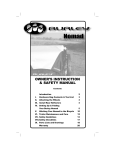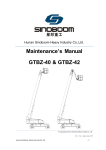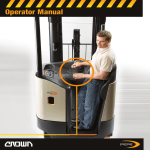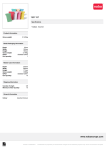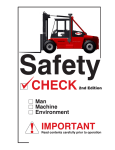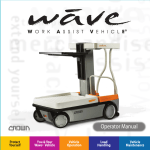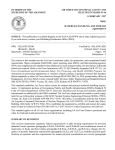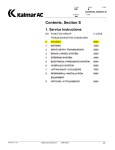Download Operator Manual - Crown Equipment Corporation
Transcript
SC 4500 SERiES Operator Manual This operator manual has information for all models of SC 4500 series plus some options and accessories. Some of the illustrations and information may not apply to your truck. The most important component is you. New Bremen, Ohio 45869 USA © 2006 PF14704-WEB Printed in U.S.A. SC You Must be Trained WARNING It’s the law, you must be trained and certified to operate this truck. (OSHA § 1910.178, Rev. 1999) You or others around you can be seriously injured or even killed if you don't use this truck correctly. Read and obey all warnings and instructions in this Manual* and on the truck. STOP IT'S THE LAW, YOU MUST BE TRAINED AND CERTIFIED Federal law states that only properly trained operators are permitted to operate a powered industrial truck and that your employer must train you and certify that you are qualified to operate this powered industrial truck. (OSHA §1910.178, Rev. 1999) Do not operate this truck in your work place until you have been trained and certified by your employer. Head, arms, hands, legs or feet outside the operator area can be pinned or crushed whenever the truck is moving. Stay within the operator area and stop the truck completely before getting off. A dockboard can move or drop while you are on it. Or you could drive off a dock. Falls from docks or dockboards can cause serious injury or even death. You could be killed or seriously injured if you are not adequately trained for lift truck operation! You can be trapped or crushed by objects protruding or poking into the operator area. Look where you are going. Inspect your truck before starting work, make sure it is in good working order. * Additional copies of this Operator Manual and all Truck Labels can be obtained from Crown Equipment Corporation, New Bremen, Ohio 45869 U.S.A. All rights reserved under International and Pan American copyright conventions Copyright 2006 Crown Equipment Corp. 1 Warning You Must be Trained 2 Protect Yourself Know the Hazards Know the Hazards WEAR YOUR SEAT BELT Falling from a truck can cause serious injury or even death. • Fasten your seat belt and pull it snug before operating your truck. Keep it fastened until you leave the truck. AVOID FALLS AND TIPOVERS Tipovers are very serious accidents. You can be crushed or even killed if you try to jump clear of an overturning or falling center-control truck. Keep your seat belt fastened, grip the steering wheel tightly, brace your feet, and push yourself back between the side restraints. The best way to prevent injury is know where you are at all times and follow the rules of safe truck operation. • Be extremely careful when working around docks, dockboards and trailers. • Stay with your truck. Don't jump from an overturning or falling center-control rider truck. Note: This is not like end-control rider trucks, where it is recommended that the operator exit the truck in these emergencies. • Use forward tilt only when you have the load in a rack, over a stack or close to the floor. DRIVE CAREFULLY • Never stick your foot, hand, head or any part of your body outside the operator area, no matter how slow the truck is moving. Anything caught between the truck and a fixed object will be crushed or even cut off. • Travel with the load or forks close to the ground and tilted back. Watch for overhead obstructions. Perform all truck movements smoothly and at a speed that will give you time to react in an emergency. • An unloaded truck can tip over also. Be just as careful using an unloaded truck as you are a loaded one. • Stay away from the edge of docks and ramps. Make sure dockboards are secure. Check that trailer wheels are chocked. You could be seriously injured or even killed in a fall from a dock or dockboard. WARNING • Keep your truck under control at all times. Drive at a speed that allows you to stop safely. Be even more careful on slippery or uneven surfaces. Do not drive over objects on the floor. LOOK WHERE YOU'RE DRIVING • Always be alert to the area around you and watch where you are driving. You could be pinned or crushed by objects intruding or poking into the operator area. 3 Protect Yourself Stay clear of all moving parts. Moving parts can cut or crush hands, feet, arms or legs. 07 USE YOUR TRUCK SAFELY • Keep your hands and feet away from all moving parts such as chains, wheels or mast. Make sure the load backrest is in place, when required. • Never stand on or under the forks, or allow anyone else to stand on or under them. The only way to lift people is with an approved platform. Never allow passengers on the truck. There is no safe place for them. • Before you leave your truck: Come to a complete stop, lower forks to the floor and shut the truck off with the key or power disconnect. Protect Yourself 4 Contents What’s in it for You? You Must be Trained 2 Protect Yourself 3 Contents 5 What's in it for You? 6 Your Sit-Down Rider 7 Lift Truck Parts 9 Capacity & Load Center 11 Capacity Plate 13 Power On & Off 15 Raise/Lower, Tilt & Accessories 16 Display 17 Braking 18 Traveling & Plugging 19 Daily Safety Check 21 Be a Safe Driver 23 Battery Maintenance 27 Notes 29 Warning Labels 30 5 Contents Capacity & Load Center Know the Hazards SAMPLE CAPACITY PLATE The information shown on this sample plate does not apply to your truck. Truck Weight with Max. Battery SC 4500 Units of measure, kg/mm(lb/in) 3290(7250) Serial Number 12345678 PLE S A M600(24) Capacity with Mast Vertical Attachment Data 600(24) Sideshifter-100(4) SERI ES Truck Type E 620-A Capacity 1360(3000) 1430(3150) 1090(2400) 1145(2520) M PL E 1 4825(190) 4370(172) 4825(190) 4370(172) SA Warning WHAT'S IN IT FOR YOU? The better you understand your truck and how to use it, the better and safer operator you can be. Here are some guides to using this manual. 600(24) 760(30) 760(30) QUICK LOCATORS In addition to the "Contents" page you can use page headings to find topics. Some pages also have a picture of the truck in the corner showing features or functions covered on that page. "KNOW THE HAZARDS" Watch for and read these special blocks. You will find information about possible safety hazards and how to avoid them. HOW-TO-DRAWINGS On many pages you will find pictures as well as text to help you understand how to use your truck safely and productively. 11 Capacity & Load Center Capacity & Load Center 12 What’s in it for You? 6 Your Sit-Down Rider SIT-DOWN RIDERS Your sit-down rider truck lifts and stacks loads. It is also designed to move loads over long distances. YOUR RIDER TRUCK IS NOT AN AUTOMOBILE With a load it may weigh more than 3 automobiles, and the steer wheels are in the rear instead of the front. FORK FUNCTIONS, STANDARD AND OPTIONAL Standard fork or hydraulic functions are: Raising and Lowering the forks plus Tilting the mast. Accessories such as Sideshift or Carton Clamp may also be included. Your company has decided which features are needed in your work area and should train you how to use them. HOW TO DRIVE YOUR TRUCK Sit down, fasten your seat belt and pull it snug. Adjust the seat and steering wheel to their most comfortable positions. Keep your hands on the controls and your entire body inside the operator area. Look in the direction you are going. BUILT TO STANDARDS This truck was designed and built to current industry and government standards and guidelines. For more information see the following: • American National Standards Institute (ANSI/ITSDF) B56.1 • Occupational Safety and Health Act (OSHA) §1910.178, Rev. 1999 • Underwriters Laboratory (UL) 583 • National Fire Prevention Association (NFPA) 505 Hands-on controls Seated Seat Belt Fastened GIVE YOUR BODY A BREAK Take advantage of stop time. Flex your arms and legs. Staying alert will help you be a better and safer driver. 7 Your Sit-Down Rider Your Sit-Down Rider 8 Lift Truck Parts Tilting Mast Overhead Guard Seat Seat Belt Seat Adjust Lever Battery Cover Latch Load Backrest Power Unit Battery Disconnect Hydraulic Levers Display Accelerator Pedal Battery Drive Wheels Forks Key Switch Service Brake Pedal Horn Steer Wheels Steering Wheel Tilt Lever Direction Control 9 Lift Truck Parts Lift Truck Parts 10 Capacity & Load Center Know the Hazards Center of evenly distributed load 600mm (24 in) Max Load Center WHAT IS YOUR TRUCK CAPACITY? Capacity is the load (including pallet or container) that can be lifted to a given height at a given load center. See the capacity plate on your truck. Make certain you use the correct units of measure. WHAT IS LOAD CENTER? Load center is the distance from the load backrest or vertical face of the fork to the center of an evenly distributed load. LOADS MUST BE EVENLY DISTRIBUTED Your truck could tip over, in any direction, if a load is shifted to the front or side of a pallet or container. SAMPLE CAPACITY PLATE The information shown on this sample plate does not apply to your truck. Truck Weight with Max. Battery SC 4500 Units of measure, kg/mm(lb/in) 3290(7250) 600(24) Sideshifter-100(4) SERI ES Serial Number 12345678 PLE AM S 4825(190) 600(24) Capacity with Mast Vertical Attachment Data Truck Type E 620-A Capacity 1360(3000) 1430(3150) 1090(2400) 1145(2520) 4370(172) 4825(190) 4370(172) 600(24) 760(30) 760(30) KNOW YOUR LOAD Do not exceed the capacity shown on your truck's capacity plate. Be careful when handling long, high or wide loads. Do not handle unstable loads. EXCEEDING TRUCK CAPACITY CAN CAUSE AN ACCIDENT Know the capacity of your truck as shown on your capacity plate. Make certain you use the correct units of measure. Pay attention to: • Weight of load • Load center • Lift height • Position of mast CENTER THE LOAD Your truck could tip over if a load is shifted to the front or side of a pallet or container. Make sure your load is evenly distributed and centered over the forks. HYDRAULIC OPERATIONS CAN AFFECT STABILITY Capacities shown on your capacity plate are with the mast vertical. Be extra careful when tilting a load. (This also applies to other accessories or attachments your truck may have, such as sideshift, carton clamp, pushpull, etc.) 11 Capacity & Load Center Capacity & Load Center 12 Capacity Plate CAPACITY PLATE INFORMATION The capacity plate is on the overhead guard. It contains: • Truck serial number • Capacity information (load, load center and lift height) • Truck type (a fire safety rating) • Truck weight with battery (does not include load) • Attachment information (if any) READING YOUR CAPACITY PLATE Capacity may be reduced as lift height increases. For example: On the sample plate, 1405kg (3100 lb) can be lifted to 4370mm (172 in). But above 4370 (172), to 4825 (190), capacity is reduced from 1405 (3100) to 1360 (3000). Capacity is reduced as load center increases. For example: On the sample plate, 1405kg (3100 lb) can be lifted if the load center is 600mm (24 in). But if the load center is increased to 760mm (30), capacity is reduced from 1405 (3100) to 1145 (2520). SAMPLE CAPACITY PLATE The information shown on this sample plate does not apply to your truck. Caution: You may not increase capacity if load center is less than shown on your capacity plate. Truck Weight with Max. Battery SC 4500 Units of measure, kg/mm(lb/in) 3290(7250) 600(24) Sideshifter-100(4) SERI ES Serial Number 12345678 13 Capacity Plate P SAM Capacity with Mast Vertical Attachment Data Truck Type E 620-A Capacity 1360(3000) 1430(3150) 1090(2400) 1145(2520) 4825(190) 4370(172) 4825(190) 4370(172) LE 600(24) 600(24) 760(30) 760(30) Note: ANSI/ITSDF B56.1 requires that all data be shown first in Metric units and then USA units. OTHER LIFT HEIGHTS AND LOAD CENTERS Contact Crown for capacities at lift heights or load centers not given on your capacity plate. Know the Hazards TRUCK WEIGHT Dockboards, elevators and some floors have limited capacity. Check your capacity plate for the weight of your truck. Remember to add the weight of the load you have on the forks. Make certain you use the correct units of measure. TRUCK TYPE Some truck types are not permitted in areas where there are fire hazards. Watch for marked areas. For example: You must not drive a type E or ES truck into an area restricted to EE or EX trucks. ATTACHMENT DATA If an attachment on your truck does not match the information given on your capacity plate, don't operate your truck. Your capacity plate may be wrong. Report the problem to your supervisor. Capacity Plate 14 Power On & Off KEY UP • Turn the key clockwise to TEST (yellow dot). Make certain the display is working. • Let go of the key and it will return to ON (green dot). • Turn key counterclockwise to OFF (red dot) to shut the truck off. Always turn key to OFF when leaving truck. TO BEGIN TRAVEL AFTER KEY UP: • Place direction control in neutral. • Step down firmly on the service brake pedal, then release. POWER DISCONNECT Pull the battery connector up to disconnect the battery and cut power to the truck. Use the power disconnect to shut the truck down any time it isn't working right. Don't use the truck if it’s not working right. Report the problem to your supervisor. Raise/Lower, Tilt & Accessories Raise/Lower lever (standard) Tilt lever (standard) Accessory lever (optional) HYDRAULIC LEVER OPERATION Pull the lever toward you, away from the mast, and you'll get the action shown by the symbol in the top of the lever. Push the lever away from you, toward the mast, and you'll get the opposite action. The farther you move the handle from neutral, the faster the action will be. For example: Pull the Raise/Lower lever toward you to raise the forks, as shown by the symbol. Push the lever away from you to lower the forks. Note: The left side of each lever has a different shape, to help you identify the lever by feel. Know the Hazards HYDRAULIC OPERATIONS CAN AFFECT STABILITY Capacities shown on your capacity plate are with the mast vertical. Be extra careful when tilting a load. (This also applies to other accessories or attachments your truck may have, such as sideshift, carton clamp, pushpull, etc.) 15 Power On & Off Raise/Lower, Tilt & Accessories 16 Display Braking SERVICE BRAKE BATTERY CHARGE STATUS The green bars show how much charge is left. Have the battery changed or recharged if the yellow light is flashing. Step down on the brake pedal to apply the brakes. The harder you step down, the harder the braking will be. MESSAGE DISPLAY Displays truck information such as: hours of operation, event codes along with instructions, battery charge and other data. PARKING BRAKE The parking brake is automatically applied after the truck comes to a stop. BATTERY RETAINER LIGHT (OPTION) A red light will come on if the battery retainer is not properly installed. (BATTERY GATE OPEN displayed) Avoid parking on inclines. But if you must, block the wheels of your truck. Step down firmly on the service brake pedal to release the parking brake. SERVICE & OPTION BUTTONS See Service Manual for instructions. PERFORMANCE SETTING Indicates the level that your company has programmed this truck to operate at. EVENT LIGHT (OPERATOR CORRECTABLE) A yellow light will come on when there is a detected event which the operator can correct. See the message display for instructions. SERVICE LIGHT (SERVICE REQUIRED) A yellow light will come on when there is a detected event which requires service. Contact your supervisor or service department. 17 Display Know the Hazards ? MAKE SURE YOUR BRAKES WORK Test the brakes on your truck at the start of each shift. Know the distance it takes to stop before you start working. If at any time the stopping distance is too long for you to stop safely, don't drive the truck. Report any problem to your supervisor. AVOID PARKING ON INCLINES Block the wheels of your truck if you must park on an incline. Braking 18 Traveling & Plugging BEFORE YOU DRIVE Adjust the operator seat and steering wheel to their most comfortable positions. Fasten your seat belt and pull it snug. TO BEGIN TRAVEL AFTER KEY UP: • Place direction control in neutral. • Step down firmly on the service brake pedal, then release. TRAVEL DIRECTION AND SPEED Move the direction control lever away from you, toward the mast, to travel forks first. Move the control toward you, away from the mast, to travel power unit first (forks trailing). Use the accelerator on the floor to control travel speed. The farther you push it down, the faster the truck will go. If the truck will not move, check the message display. • RETURN TO NEUTRAL means the direction control must be put in neutral. • DEPRESS BRAKE PEDAL means the brake pedal must be depressed firmly to release the parking brake. PLUGGING Plugging is another way to slow down or stop your truck. While the truck is moving, in either direction, select the opposite direction of travel. Use the accelerator to control how quickly you slow down. Plugging will not stop your truck as fast as using the foot brake. Plugging does not hurt your truck. 19 Traveling & Plugging HORN Press the center of the steering wheel to sound the horn. Use it to warn pedestrians and other drivers. Use your horn when you leave an aisle or come to a crosswalk or intersection. Know the Hazards SLOW DOWN FOR SPILLS OR WET FLOORS Powder or liquid spills can cause slippery floors. Slow down or you could lose control of steering and braking. Be careful and allow for a longer stopping distance. Don't run over objects on the floor. PLUGGING VS. BRAKING Of the two, the foot brake is designed to stop the truck in the shortest distance. Use the foot brake in an emergency, on ramps or in busy areas. POWER UNIT SWING Be careful turning while traveling forks first. The power unit will swing wide in the opposite direction. Make sure you have clearance, and watch out for people in the area. LOOK WHERE YOU'RE GOING Travel in the direction that gives you the best view. Traveling & Plugging 20 Daily Safety Check CHECK YOUR TRUCK BEFORE STARTING WORK You must make sure your truck is safe to use. 1. Walk around your truck and check it over. • Check to make sure the battery is charged and vent caps are in place. Check water level weekly. Don't use an open flame to check the battery. • Inspect battery cables and connectors for damage or corrosion. • Be certain the battery retainer is properly installed. • See that all wheels are in good condition. • Check that both forks are secure and not bent, cracked or badly worn. • Inspect all lift chains for damage. • See that the load backrest is in place and secure, when required. • Look under the truck for signs of leaks. • Inspect the seat belt for wear. • Turn the key to ON. Check the display. • Test the horn. 2. Test drive your truck in an uncongested area. • Adjust the operator seat and steering wheel to their most comfortable positions. • Fasten your seat belt. • Try all the hydraulic functions. • Check that the steering is easy and smooth. • Drive the truck slowly in both directions. • Drive through the full speed range in both forward and reverse. • Check braking and plugging distances in forward and reverse. Load size and floor conditions can affect these distances. • Know the distance it takes to stop before you start working. If the braking distance is too long to stop safely, don't drive the truck. If anything doesn't look or feel right, don't drive the truck. Report the problem to your supervisor. You can get checklist forms from your Crown dealer (part no. OF 3772). Used properly, this checklist can alert service people to needed repairs. • Make sure you can read the capacity plate. 21 Daily Safety Check Daily Safety Check 22 Be a Safe Driver DRIVE CAUTIOUSLY, BE ALERT The most important component is you. MAKE SURE YOU ARE READY TO DRIVE • Do not use this truck unless you are trained and certified. • Be certain you understand how your truck works and the hazards that go with it. Don't drive the truck if you have any doubts. • Never stick an arm or any part of your body outside the operator area, no matter how slow the truck is moving. A hand or foot caught between the truck and a fixed object will be crushed or even cut off. • Know the capacity of your truck (Load Weight, Load Center and Lift Height). Make certain you use the correct units of measure. • Keep your hands on the controls and your feet by the pedals. • Some trucks are not allowed in areas where there are fire hazards. Be certain your truck is the correct fire safety type for the area. • Make sure your hands and shoes are clean and dry, and your clothing is proper for the job. ? • Adjust the seat and mirror. • Fasten your seat belt and pull it snug. MAKE SURE YOUR TRUCK IS READY • Inspect your truck before using it (see pages 21 and 22). If it's not working right, or something is broken, report the problem to your supervisor. Don't use the truck. • In an open area, test the brakes and plugging. Check at a slow travel speed first, then a faster one. Know the distance it takes to stop before you start work. • Travel in the direction that gives you the best view. Look where you are going and slow down in congested areas. • Slow down for wet or slippery floors. Don't run over things. • Travel with the forks close to the ground and tilted up. Place the load against the load backrest (vertical face of the forks). • Look where you are going before you change direction of travel. • See that you have room to drive and turn. Always check for overhead objects. • Slow down when making turns. • Avoid sudden movement of controls. Learn to use them smoothly at a moderate, even rate. • Check clearances before raising or lowering the forks or load. • Be extra careful if you must use your truck in an area where there is a risk of falling objects. Continued next page... 23 Be a Safe Driver Be a Safe Driver 24 Be a Safe Driver continued WATCH OUT FOR OTHER PEOPLE • Slow down. Yield or stop for pedestrians. Use your horn when you come to a crosswalk or intersection. AVOID FALLS AND TIPOVERS • Stay with your truck. Don't jump from a moving or falling sit-down truck. • Be careful that you don't pin or crush someone. For example: Never drive your truck toward anyone standing in front of a fixed object. • Check that bridgeplates and dockboards are secure. Be certain that either the trailer wheels are chocked or the trailer is locked to the dock. Check capacities. Be sure your truck, with load, isn't too heavy for where you are driving. • Watch out for power unit swing. • Never allow passengers on your truck. • Keep others away from your truck while you're working. Don't ever allow anyone on or under the load or forks. • Don't let anyone use your truck unless they are trained and certified. • Never lift anyone with the forks unless they are using an approved platform. Even then, use extreme caution: • Use a securely attached and approved safety platform. • Make certain lifting mechanism is operating properly. • Have mast vertical (never tilt when elevated). • Make certain direction control lever is in neutral. • Lift and lower slowly. • Watch for overhead obstructions. • Be sure you can see and hear the person being lifted. • Never transport anyone on the platform from one location to another. • Stay away from the edge of docks and ramps. • Make sure the load you are moving is stable. Spread forks as far as you can and center the load. Insert forks as far under the load as you can. Be even more careful with long, high or wide loads. They can be less stable. • Use forward tilt only when you have the load in a rack, over a stack or close to the floor. Use minimum fork tilt to pick up or place a load. When lifting or lowering outside a rack, keep the mast vertical or tilted back slightly. • When moving loads on grades or ramps, drive with forks pointed upgrade. Without a load, drive with forks downgrade. Slow down. Don't turn on grades or ramps. Don’t raise the mast while on a grade or ramp. LEAVING YOUR TRUCK • Stop your truck completely before getting off. • Lower the forks to the floor. Turn the truck off or disconnect the battery. • Avoid parking on inclines. But if you must, block the wheels of your truck. 25 Be a Safe Driver continued Be a Safe Driver continued 26 Battery Maintenance Know the Hazards WHEN YOU INSTALL OR CHANGE A BATTERY • Turn the truck OFF and check that all controls are in neutral. Disconnect the battery. Tilt the steering wheel up and raise the battery cover. Remove the side cover and battery retainer. • Make certain you use the correct size and weight battery. Never operate a truck that has an underweight or undersized battery installed. • If you use a roller stand to install or remove a battery, make sure the roller stand is the same height as the rollers in your truck's battery compartment. Also make sure the roller stand is at least as long as the battery. • Never smoke or use an open flame around batteries. Batteries produce explosive gas. Do not smoke, use open flame, or create an arc or sparks near this battery. Ventilate well in enclosed areas and when charging. AFTER INSTALLING YOUR BATTERY • Replace the battery retainer and side cover. • Lower and latch the battery cover. • Connect the battery. • Return the steering wheel to a comfortable position. Turn the truck ON and check truck operation. • Your company should provide an area where it is safe to work on batteries. Use that area for all battery work. Batteries contain Sulfuric Acid which causes severe burns. Do not get in eyes, on skin, or clothing. In case of contact, flush immediately. Get medical attention if your eyes are affected. • Never let anything metal touch the top of the cells. You could cause sparks or do damage to the battery. Use an insulator (such as plywood) when necessary. • Use an approved spreader bar to move a battery to, or from, the battery compartment or stand. Make sure you adjust the spreader bar hooks to fit the battery. TRUCK BATTERIES CAN BE DANGEROUS Your truck battery produces gas that can explode. It also contains acid that could burn or disfigure you. • Do not try to install, remove, charge or service your truck battery unless you are trained and authorized. DANGER 107 WARNI NG Minimum battery size allowed 000 mm (00.00 in.) wide 000 mm (00.00 in.) long Undersize battery can affect truck handling and stability. You could have an accident. Use U.L. classified Type EO battery. • Use protective equipment such as gloves, eye shields, aprons etc. when working on batteries. BATTERY RETAINER MUST BE IN PLACE The battery could slide out if the retainer is not in place. Check that the retainer is installed and secure. BATTERY SIZE AND WEIGHT IS IMPORTANT Make certain you use the correct size and weight battery. Never operate a truck that has an underweight or undersized battery installed. BEFORE CHARGING YOUR TRUCK BATTERY • See that the battery cells are filled to the proper level. Never use an open flame to check the batteries. • Check that the charger is the same voltage and amperage as the battery. Read the battery charger instructions. • Be sure the charger is turned OFF before connecting the battery to the charger. Otherwise a spark could cause the battery to explode. Also, make sure the truck key switch is turned off and all controls are in neutral. 27 Battery Maintenance Battery Maintenance 28 Notes Warning Labels EACH WARNING LABEL ON YOUR TRUCK IS IMPORTANT Read and obey all of them to protect yourself and others. WARNI NG It’s the law, you must be trained and certified to operate this truck. (OSHA § 1910.178, Rev. 1999) You or people around you could be seriously injured or even killed if you don't use this truck correctly. WARNI NG Minimum battery size allowed 000 mm (00.00 in.) wide 000 mm (00.00 in.) long Undersize battery can affect truck handling and stability. You could have an accident. Use U.L. classified Type EO battery. Obey all instructions & warnings in the operatorWARNING manual and on the truck. Lifting people without Stay clear of all moving parts. a proper platform could Avoid being cause a fall or other crushed. serious injury. Keep head, Platform must be built WARNING arms,hands, and used as specified OSHA 1910.178 and legs, and in feet ANSI-B56.1. WARNI NG within the operator area. Stop truck completely Passengers could be before getting off. seriously injured. Falls from docks can cause serious injury or even death. Keep seatbelt fastened, hold on, and brace your feet in these emergencies. There is no safe place for them to ride. No Passengers. * Additional copies of the Operators Manual and Truck Labels can be obtained from: Crown Equipment Corp. New Bremen, OH 45869 DANGER Tilting mast forward when forks are raised and loaded can tip the truck over causing injury or death. Do not tilt elevated load forward unless it is over a stack. WARNING You can tip this truck over if you turn too sharply for the conditions around you. Don't risk injury or death. You could be WARNING WARNI NG pinned or crushed by objects intruding or poking into the operator area. Look where you are going. Inspect your truck before starting work, make sure it’s in good working order. Moving parts can cut or crush hands, feet, arms or legs. Falling objects or lowering forks can cause serious injury or death. Never stand under the forks. Slow down when turning. Buckle seatbelt WARNI NG Batteries can produce explosive gas. Do not smoke, use open flame, or create an arc or sparks near this battery. Ventilate well when in an enclosed area and when charging. This battery contains Sulphuric Acid which causes severe burns. Do not get in eyes, on skin, or clothing. In case of contact, flush immediately and thoroughly with water. Get medical attention if your eyes are affected. Standing or riding on the forks can cause a fall. You can be seriously injured or killed. Never stand or ride on forks for any reason. While servicing, block the forks so they won't fall. In case of tip-over Follow these instructions: Don't jump! Hold on tight Brace feet All rights reserved under International and Pan American copyright conventions Copyright 2006 Crown Equipment Corp. 29 Notes Warning Labels 30

















